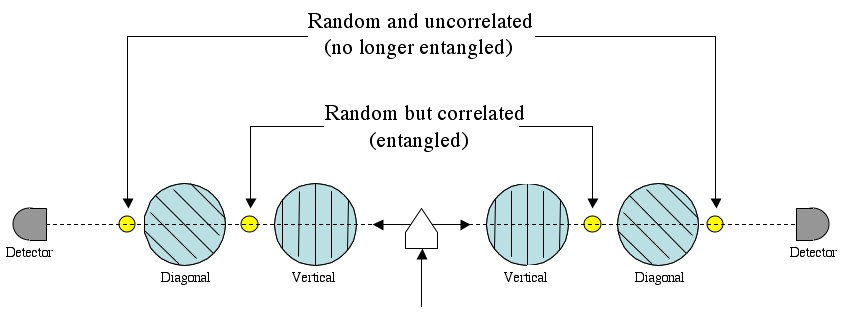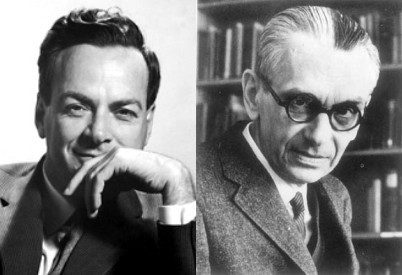Physicist: When a photon with an unknown polarization hits a polarizer it has a 50% chance of being stopped and a 50% chance of going through. However, once the photon has passed through a polarizer then its polarization is known (it’s known if it doesn’t pass through as well, but it’s also destroyed). So if it passes through a vertical polarizer, then it is now definitely vertically polarized, and will pass through additional vertical polarizers no problem (as opposed to being stopped 50% of the time).
A series of identically oriented polarizers in a row is an example of a “repeated measurement”. One of the phrases that plays on loop in the back of every physicist’s head is “repeated measurements yield the same result”. This is the sort of thing that refers too.

Two polarizers arranged vertically and arranged diagonally (and perpendicular to each other). The polarizers on the left are a little dark because about half of the ambient light is stopped.
Photons (and particles in general) come in two basic flavors: definite state and indefinite state. After passing through the first polarizer a photon will be in a definite state (definitely polarized in the same direction as the polarizer). The spooky thing about indefinite states is that they’re actually in both polarizations at the same time (like Schrödinger’s cat, or particles taking multiple paths in the double slit experiment), as opposed to the polarization merely not being known. Take a moment to ponder…
Normally the polarization of one photon has nothing at all to do with the polarization of another. However, by using slickness (there are several methods), photons can be prepared in pairs so that 1) both measurements are the same, and yet 2) both photons are in indefinite states (both horizontal and vertical).
These specially prepared photons are “entangled”. Entanglement is a property that any particle can have (not just photons), and more complicated forms can be shared by an arbitrary number of particles.

A down-converter (one way to produce an entangled pair) throws two entangled photons in opposite directions. When measured the same way by polarizers, these entangled photons always yield the same result.
Entanglement requires that the particles be in an indefinite state. If you prepare two photons to be diagonally () polarized (a definite state) then they both have a 50% chance of passing through either a horizontal or vertical polarizer (and 100% chance of passing through a diagonal polarizer like this:
, and 0% chance of passing through a diagonal polarizer like this:
). However, if one photon passes through a vertical polarizer, it has no bearing on the other. They’re in the same state, but they are not entangled.
Entangled photons always give the same result for the first measurement, so long as the two polarizers are oriented in the same direction; both vertical, both diagonal, whatevs. However, as soon as either photon is measured, you’ll find that they are both in exactly the same (no longer entangled) state. If you keep measuring the same polarization, the photon will keep going through (repeated measurements). However, if you start measuring with different orientations, there is no longer any reason for the photons to always give the same result (the way they did when entangled).

Entangled photons always yeild the same result for the first measurement. However, the first measurement destroys the entanglement. Subsequent, different measurements have random results.
If you want to impress your friends and family with vocabulary, the process of breaking entanglement is called “decoherence”. It’s the big problem with getting quantum computers off the ground. I get pretty excited about entanglement and whatnot, so what follows is answer gravy.
How the (fairly easy) math is done:
A photon that is vertically polarized can be written as and horizontally as
. This weird looking notation doesn’t mean anything profound. It’s basically saying “look! some kind of quantum state!” As it happens, a diagonally polarized photon can be described as
which is just a technical way of saying “up and to the right is half up and half to the right”. The other diagonal polarization is
.
The chance of finding a photon described by in a state
is given by
, where
is the angle between the two states. For example, the chance of finding a vertically polarized photon in the horizontal state is
impossible, which is what you would expect. The chance of a diagonally polarized photon being detected as vertical is
.
Another way of doing exactly the same thing is:
Now say you have two photons (A and B) that are vertically polarized, you’d write it this way:
Where the A and B subscripts indicate which particle you’re talking about in that bracket.
Here’s how you would write the state of two diagonally polarized photons:
Holy crap! This is just another way of saying that the chance of measuring any combination of vertical and horizontal polarization is equal. Check it! The probability of A being vertical and B being horizontal is:
Notice that the “A” parts and the “B” parts leave each other alone.
Now here’s an example of a Bell state:
(For succinctness you can write this: , just be careful to keep track of which is A and which is B.) This says that the chance of both photons being vertically polarized is 1/2, and the chance of both of them being horizontally polarized is also 50%. Even though this Bell state looks like diagonal polarization, it’s not. A diagonal state is definite:
If you measure this using vertical/horizontal polarizers you’ll find that the photon has a 50/50 chance of passing through, which seems like an indefinite state. However, using diagonal polarizers you’ll find that this is definitely a “upright/downleft” polarized photon.
If you rewrite the Bell state in terms of diagonal states (right now it’s written in terms of vertical/horizontal states) you get:
So the Bell state will also always yield the same result for both photons when measured diagonally. Isn’t that weird?
Now say you fire a pair of entangled photons in this state at a pair of vertical polarizers. If one goes through, they both go through and you’re left with a definite state:
Which in terms of diagonal states is:
Which means an equal chance of any combination of measurements! No correlation! No entanglement! That mother decohered!
By the by, for fermions (which includes protons, neutrons, and electrons) the important state is “spin”, not polarization. And for fermions the probability of a particle which is known to be in the state being measured in state
is
, where
is the angle between the axis of the spins. Without going into detail, the
term is essentially due to the “half integer spin” of fermions, as opposed to the “integer spin” of photons.









